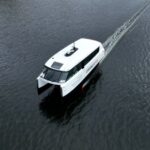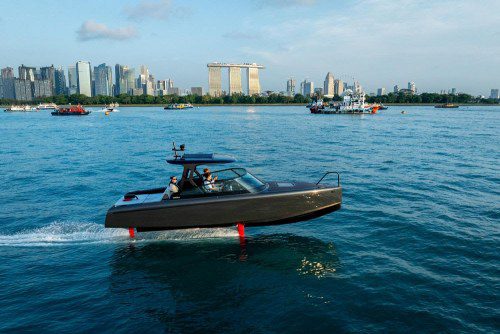 Skip traffic jams and fly to work on the world’s fastest electric ship? Next week, Candela will demonstrate how zero-emission waterborne transport could transform commuting on the Hudson River.
Skip traffic jams and fly to work on the world’s fastest electric ship? Next week, Candela will demonstrate how zero-emission waterborne transport could transform commuting on the Hudson River.
(Media Test Drives Available)
New York is one of the most congested cities in the world, yet its waterways remain largely untapped for high-speed waterborne transport. That could soon change according to Swedish tech company Candela, which will showcase the world’s first foiling electric vessel on the Hudson River on August 21 and 22.
Candela recently launched the Candela P-12, a 30-passenger electric hydrofoiling commuter ship that flies above the water on underwater wings attached to its hull. At speeds above 20 mph, the P-12 begins to lift off. As it reaches a cruising speed of 30 mph, it soars above the water, using a staggering 80% less energy than conventional boats.
This breakthrough in energy efficiency is key to transforming waterborne transport from its current diesel-fuming, inefficient, and costly state to a clean, quick, and affordable alternative.
Current commuter ships are among the world’s most inefficient and polluting forms of transport. New York’s ferries, for example, have found to emit seven times more CO2 per passenger mile than gasoline cars, while nitrogen oxides (NOX—a major contributor to ozone) emissions can be over 1,000 times greater.
As conventional ships plow through water, they consume large amounts of energy, making them difficult to electrify since batteries contain much less energy than diesel. They are also costly to operate and create large, damaging wakes that can limit their speed in city centers’ no-wake zones.
By flying above the water, the P-12 eliminates the drawbacks of traditional ships.
“P-12 is the first electric ship with long range and high speed, thanks to its efficiency,” explains Gustav Hasselskog, CEO and founder of the Swedish marine tech company.
The Candela P-12 has a range of 40 nautical miles on battery power at a cruising speed of 25 knots, making it the fastest electric vessel on the planet with the longest range. When flying, it creates a barely visible wake, which has earned it an exemption from speed limits in Sweden’s capital Stockholm, where it will be integrated into public transport this fall. Thanks to this, it will cut travel times in half compared to cars and buses—something Hasselskog believes can be achieved in New York as well.
“New York was built by the water because waterways are humankind’s oldest transport infrastructure. With hydrofoil technology, we believe waterborne transport will see a resurgence for intra-city travel as it can be faster than cars and cheaper than building subways or bus lines,” says Hasselskog.
With the P-12’s convenient capacity of 30 passengers, new direct routes between currently unserviced destionations could offer quick, economically viable connections. For example, a direct line between Chelsea Market in Manhattan and Hoboken Terminal would take less than three minutes. A ride from the Staten Island Ferry Terminal to Pier 15 in the Financial District would only take 11 minutes.
“Just like in Stockholm, passengers could look forward to spending more time with their families or working instead of being stuck in traffic. Candela’s goal is to unlock the true potential of our waterways,” adds Hasselskog.

Candela will perform media and client demos with their C-8 demonstration vessel in New York on August 21st and 22nd, followed by demos in Sag Harbor from August 23rd to 25th.




















